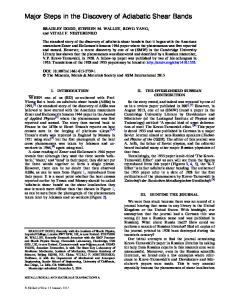Development of shear bands in annular shear granular flows
- PDF / 184,679 Bytes
- 6 Pages / 612 x 792 pts (letter) Page_size
- 56 Downloads / 414 Views
MM3.3.1
Development of shear bands in annular shear granular flows Payman Jalali and Mo Li School of Material Science and Engineering, Georgia Institute of Technology, Atlanta, GA 30332
ABSTRACT Using hard-disk simulations of relatively dense packs of mono-sized system in an annular Couette geometry the formation of dilute regions inside the granular media, namely shear bands, are investigated. The results represent the influence of entire system characteristics such as solid area fraction and shear rate on the development of shear bands as well as the local properties of grains that cause them to participate in the formation of a shear band. Moreover, simulations have been performed for binary-sized system, which revealed that the formation of such diluted shear bands is unlikely.
INTRODUCTION Granular systems have been studied in recent years in different ways [1]. Some of issues such as force fluctuations [2] are investigated with a specific attention either experimentally or theoretically. Another interesting domain in the field of granular matter, i.e., shear band formation, has been brought to scientists’ attention through a series of recent papers [3]. However, it was already investigated experimentally some decades ago [4]. A shear band may be simply defined as the region with a finite width of the order of 5-10 grains diameters within which grains undergo a larger displacement (or its gradient) relative to the adjacent regions. Experimental observations [5,6] in annular Couette geometry have clearly shown the existence of shear zones, which are formed peripherally in the vicinity of shearing wall. However, the details of system behavior under shear band formation are not precisely studied. In the current paper, we present some of the numerical results in 2D annular shear cell using hard-disk model. We discuss on the structural features of system related to the formation of shear bands as well as the effect of size diversity on diminishing the formation of shear bands. DESCRIPTION OF GEOMETRY AND MODEL The geometry of systems boundaries is created by inserting hundreds of similar disks on two concentric circular cylinders with radii of R0 and Ri. The distance between successive particles on the cylindrical walls is randomly selected but it is small enough to prevent escaping of any particle across the wall. The area between the two walls is filled with a proper number of disks to result a given packing density. The initial packing of disks is a regular triangular lattice with each node as a central site of a particle. The overall packing density and shear rate are determined by
ϕ = .25(∑i =1σ i2 ) /( Ro2 − Ri2 − 1 / 8 ∑w=1σ w2 ) and γ = Ri ω i − Roω o /( Ro − Ri ) , respectively. N
Nw
MM3.3.2
The diameter of a free particle is denoted by σ i and the size of a wall particle is σ w . The rotational speed of the inner and outer walls are represented by ω i and ω o . Simulations are carried out using the hard-disk model, which is described in details through a number of earlier works [7]. This model work
Data Loading...











